






1430 On Jan. 7 Valois duke of Burgundy (since 1419) Philip III the Good (1396-1467) marries his 3rd wife, good Portuguese princess Isabel of Aviz (1397-1472), only surviving daughter of John I; on Feb. 10 in Bruges he establishes the Order of the Golden Fleece (Toison d'Or), the Burgundian version of the British Order of the Garter to secure allegiance from the nobles of inherited fiefs incl. Hainault, which Hapsburg HRE Maximilian I extends to Austria after becoming the duke of Burgundy in 1477 - a little cross-channel cross-dressing? In Mar. after an 8-year siege (since 1422), the Ottomans reconquer Thessalonica (Salonika) from Venice, and in July the Peace of Lapseki confirms Ottoman control (until 1912), while Murad II recognizes the Venetian possessions in Greece and Albania. Speaking of cross-dressing? On May 14 Joan of Arc arrives in the village of Compiegne, rallying the French pop. and accompanying archbishop Renaud of Reims southward, then returning and fighting the Battle of Compiegne, where she is captured on May 23 in a sally by the Burgundians under Philip III the Good, and 6 mo. later is sold to the English; Philip acquires the Duchy of Brabant (founded 1183), making it part ofthe Burgundian Netherlands. On Oct. 27 Vytautas (Witowt) the Great (b. 1350) dies, and his cousin Svitrigaila (1370-1452) (with a Russian mother) becomes grand duke of Lithuania (until 1432), backed by the Orthodox pop.; meanwhile the Roman Catholic and pagan pop. goes for Sigismund Kestutaitis (1365-1440), and when Svitrigaila proclaims independence from Poland and grants privileges to his Orthodox subjects, Poland declares war and occupies the towns of Podolia, causing him to invite the Teutonic Knights to invade Poland, after which Poland folds and signs an armistice in Lutsk. The Lancastrian Parliament of England passes a law limiting the franchise for elections to forty shilling freeholders to prevent packing, which stays in force until 1832. The tiny (15-3/4 sq. mi.) country of Grand Fenwick is founded in the French Alps by Sir Roger Fenwick - (Leonard Wibberley, In this decade Modern English begins to be heard in the great outdoors? By this year most of the Greek classics have been brought to Italy. Architecture: The Cathedral of Notre Dame at Reims, France (begun 1212) is finished. Twin-towered Borthwick Castle is built in North Middleton, Midlothian, 12 mi. S of Edinburgh, Scotland. Inventions: The Mouse That Roared? 16-ton Mad Marjorie, the first cast-iron gun is introduced into battle; it has a 2-ft. bore and fires a 750 lb. stone ball. After a rope with a cloth proves inadequate, a 6' wooden Tilt Barrier is created for use in jousting tournaments in England. Between 1430-50 Tarot Cards (Egyptian "tar" + "ro" = royal way) come into use in N Italy, a descendant of playing cards that came from Muslim Mamluk Egypt in the late 14th cent., probably via gypsies, and based on the Wheel of Fortune; "Regnabo, Regno, Regnavi, Sum Sine Regno" (I shall reign, I reign, I have reigned, I am without reign"); in the late 18th cent. they begin to be used by occultists for divination and spiritual growth. Nonfiction: Anon., Liber Cure Cocorum; pub. in Lancashire, NW England; contains the first use of the word "haggis" (hagese) to mean sheep offal cooked in its stomach, which is later associated with Scotland. Matteo Palmieri (1406-75), On Civic Life (Della Vita Civile) (4 vols.); how an education in the classics at an early age is essential to make a good citizen who participates in public life like Cicero; set in a country house in Mugello during the 1430 plague, with Agnolo Pandolfini as main speaker; doesn't mention religion, but the Church is getting the BBQ grill ready for a humanist dude like this? Art: Jan van Eyck and his brother Hubert, The Crucifixion and the Last Judgment; achieves an unprecedented luminosity and intensity of color and detail by using oils on wood; The Virgin and Child with Chancellor Rolin (1430-4). Rohan Master, Les Grandes Heures de Rohan (The Rohan Hours) (1430-5); painted by an anon. artist for Yolande of Aragon (1384-42), and filled with cool miniatures portraying the agonies of Christ and grief of his mother Mary. Music: The first Dutch School of Music is founded by Gilles Binchois (de Binche) (de Bins) (1400-60) and Guillaume Dufay (Du Fay) (1397-1474), making Holland the center of European music. Births: Italian diplomat and cardinal (1467) Oliviero Carafa (d. 1511) on Mar. 10 in Naples. Scottish Stewart king (1437-60) James II ("Fiery Face") (d. 1460) on Oct. 16 in Holyrood Abbey; son of James I and Joan Beaufort; a red birthmark covers the left side of his face; twin brother Alexander dies in infancy; has six sisters and no brothers. English soldier John Howard, 1st Duke of Norfolk (AKA Jack of Norfolk) (d. 1485); knighted in 1461, created baron by Henry VI in 1470, then created earl marshal of England by Richard III in 1483. Hungarian gen. Stephen (Istvan) V Bathory of Ecsed (d. 1493); prince of Transylvania (1479-93). Italian Venetian Madonna-loving Renaissance painter Carlo Crivelli (d. 1495) (b. 1435?) in Venice; student of Jacobello del Fiore, and Antonio Vivarini; imprisoned for adultery in 1457-67; known for decoratively punched gilded backgrounds. Italian painter Cosimo (Cosme) Tura (Il Cosme) (d. 1495). English bishop (of Rochester) John Alcock (d. 1500) in Beverley; educated at Cambridge U. Italian Pitti Palace architect-sculptor Luca Fancelli (d. 1502) in Settignano, Florence; student of Filippo Brunellesci (1377-1446). German humanist astronomer Bernard Walther (d. 1504) in Memmingen; student of Regiomontanus at his observatory in Nuremberg; the first to use a clock driven by a hanging weight for the purpose of scientific measurement. French sculptor Michel Colombe (d. 1512) in Bourges. Deaths: Lithuanian grand duke (1401-30) Witowt (Vytautas) the Great (b. 1350) on Oct. 27 in Troki; dies before he can be crowned the first king of Lithuania, all approved and everything? Russian icon painter St. Andrei Rublev (b. 1360) on Jan. 29 in Moscow. French poet Alain Chartier (b. 1390); a story is later told that when Margaret of Scotland comes to France in 1436, she kisses him on the mouth, even though he's the ugliest man in France, because it's "the invaluable mouth from which issued and which left so many witty remarks and virtuous words."
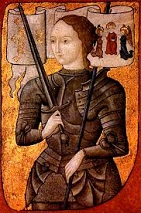
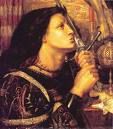
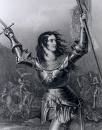

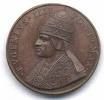
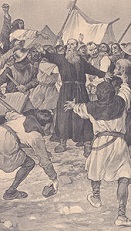
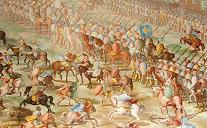

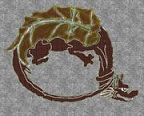

1431 On Feb. 8 Prince Vlad, son of Mircea cel Batran is given the throne of Wallachia by HRE Sigismund I, and inducted into the Order of the Dragon at Brandenburg, becoming Vlad II Dracul (the Dragon) (1390-1447); he has a son this year named Vlad III Dracula the Impaler (Tepes) (1431-76), who is inducted at age 5 and goes on to perfect the dragon arts without the need for Gatorade thirst quencher? On Feb. 20 Pope (since 1417) Martin V (b. 1368) dies from eating too many eels after convoking the Council of Basel (ends 1449) to deal with the pesky Hussites and Ottomans, and on Mar. 3 Gabriello (Gabriele) Condulmaro is elected Pope (#206) Eugene (Eugenius) IV (1388-1447), putting the skids on any plans to make the Church a democracy, establishing that the pope is a higher authority than a council, not vice-versa; his servant Poggius pines over the decay of Rome through the cents. There are Nuts, and There are Planter's Roasted Nuts, or, Scent of a Woman Pt. II, or Do Lobsters Have Feelings, or, When They Come to Call On You and Drag Your Poor Body Down? On May 30 after Henry VI's uncle Duke John of Bedford (uncle of Jacquetta, Duchess of Bedford, mother of Elizabeth Woodville, wife of Edward IV) has French holy warrior babe (St.) Joan of Arc( Jeanne or Jehanne d'Arc) (b. 1412), "the Maid of Orleans" tried by a stacked French ecclesiastical commission and condemned as a heretic for dressing in men's clothes, she is burned at the stake in Rouen's old market square (Place du Vieux Marche), singing out the name of her Lord Jesus; chief judge Bishop Pierre Cauchon (1371-1442) denies her a lawyer and railroads her through the rigged jury of 60 clergy and theologians on the English payroll, then falsifies the trial minutes to cover it up; too bad for Bedford, her martyrdom only fans the flames of French nationalism, and forever afterwards the idea of England trying to rule any part of France gives off bad vibes. On July 1 the Battle of La Higuerela in the grass valley (vega) of the Genil River near Genil sees the forces of Granada Nasdrid Sultan Muhammed IX defeated by Castilian forces of John II led by Alvaro de Luna, after which John II installs Muhammed IX's son Yusuv IV as sultan of Granada. On Aug. 14 the Roman Catholic Crusaders of the HRE under Frederick of Brandenburg and Cardinal Cesarini are crushed by the Taborites and Hussites under Bohemian Taborite ex-Ultraquist priest-gen. Andreas Prokop the Bald (the Great) (the Holy) (the Bald) (the Shaven) (1380-1434) at the Battle of Domazlice. On Dec. 16 Henry VI of England (b. 1421) is crowned king of France at Notre Dame in Paris. Pro-German burghers open the gates of the town of Flensburg in Schleswig, allowing the German army to march in. Angora (Ankara) (ancient Ancyra) (225 ESE of Constantinople) is conquered by the Ottomans, who also demolish the Hexamillion (Gk. "six-mile wall") Wall of Corinth (built in 408-450); it is rebuilt in 1444, breached in 1446 and Oct. 1452, and abandoned after the Ottoman conquest of the Peloponnese in 1460. James I's royal lt. Earl Alexander of Mar is defeated by the Macdonald golden arches clan at the First Battle of Inverlochy Castle (2nd in 1645), causing James I to restore Alexander Macdonald to his lordship of the Isles; meanwhile the Scottish parliament raises another tax to pay the king's ransom, but this time has it kept in a locked box under their control so he can't get at it - and play no-limit credit card Paris Hilton with it? Rene I of Anjou becomes duke of Lorraine (until 1453), adopting the Cross of Lorraine, with two graded or ungrade horizontal bars. Chinese adm. Cheng Ho (Zheng He) (1371-1433) begins his (last) Seventh Voyage from China, reaching 20 states and exacting tribute from 11 of them, incl. Muhammad's holy city of Heavy Mecca (ends 1433). After pressure from Siam, King Pohnea Yat of Cambodia quits Angkor Wat for the new capital city of Phnom Penh ("Penh's Hill") (originally Kronk Chaktomuk, "City of Four Faces) on the Mekong, Tonle Sap, and Bassac Rivers (modern-day pop. 1.5M), switching from rice agriculture to maritime trade, with China granting them commercial initiatives; the religious culture begins shifting from priestly to monastic. The U. of Poitiers is founded in Poitiers, France by Pope Eugene IV and chartered by Charles VII, becoming #2 after the U. of Paris in the 16th cent.; alumni incl. Francis Bacon, Joachim Du Bellay, Rene Descartes, and Francois Rabelais; it is closed during the 1789 French Rev., and reopened in 1796. Nonfiction: John Lydgate (1370-1450), The Fall of Princes (9 vols.) (1431-9); written for his patron Duke Humphrey of Gloucester, based on Boccaccio's "De Casibus Vivorum Illustrium", an encyclopedic account of the falls of great men in history in 36,365 lines of verse. Art: Lucca della Robbia (1399-1482), La Cantoria (The Singing Gallery) (sculpture) (Florence Cathedral) (1431-8); 10 panels of children singing and playing musical instruments to illustrate Psalm 150. Births: Italian duke of Ferrara (1471-1505) ("the North Wind") ("the Diamond") Ercole I d'Este (d. 1505) in Ferrara; father of Alfonso d'Este (1476-1534). Wallachian prince (1448, 1456-62, 1476) Vlad III Dracula (the Impaler) (Tepes) (d. 1476) (b. 1428?) on Nov. (Dec.?) 8 in Sighisoara, Transylvania; 2nd son of Vlad II Dracul (1390-1447) and Princess Cneajna; brother of Mircea II and Radu the Handsome (1437-75); half-brother of Vlad IV the Monk; the Ottomans call him Kazikli Bey ("Impaler Prince"); his daddy is invested into the Order of the Dragon in Nuremberg this year, and he follows at age 5, always displaying the symbol of the dragon when fighting, as if they didn't feel bad enough already?; born in Wallachia, but spends most of his life in exile in Transylvania to the N; after his daddy gives him and Radu to the Ottomans as a hostage, who whip him and instill a lifelong hatred for them, he never forgives daddy?; becomes known for his exaggerated justice and cruel law and order system, loving to have a bad guy's legs attached to horses while a sharpened greased stake is forced through his anus until it comes out of his mouth, and to impale bad guys upside down, and impale infants on their mothers' chests; when he impales them by the thousands, the stakes are laid out in concentric circles with the height of the stake indicating the rank of the victim; likes to stick red hot stakes in the vaginas of adulterous women and cut off their breasts; the entire list of fun and games fills volumes? English noble Edmund Tudor, Earl of Richmond (d. 1456); son of Owen Tudor and Catherine of Valois (widow of Henry V); half-brother of Henry VI; husband of Margaret Beaufort; father of Henry VII (1457-1509). French "Where are the snows of yesteryear?" poet Francois Villon (Francois de Montcorbier) (Francois des Loges) (d. 1463) near Paris; educated at the Sorbonne; assumes the name of his patron Guillaume de Villon, a prof. of canon law who adopted him as a boy. Italian pope (1492-1503) Alexander VI (Rodrigo Lanzol y Borgia) (d. 1503) in Spain; founder of the House of Borgia of transplanted Spaniards in Italy; father of Cesare Borgia and Lucrezia Borgia. Italian painter-engraver ("first great painter of the Italian Renaissance") Andrea Mantegna (d. 1506) in Isola di Carturo (near Vincenza); apprentices under Francesco Squarcione in Padua, and becomes Padua's most famous native since Livy, then in his late twenties moves to Mantua, where he becomes court painter to three gens. of Gonzagas. Scottish statesman and bishop of Aberdeen (founder of the U. of Aberdeen) William Elphinstone (d. 1514) in Glasgow; educated at the U. of Glasgow. Deaths: Italian scholar Gasparinus de Bergamo (b. 1360); leaves Liber Epistolarum (Book of Letters) (Epistolae Gasparini), a Latin grammar and composition book, which becomes the first book printed in France in 1470. English bishop Richard Fleming (b. 1385) on Jan. 25/26 in Sleaford, Lincolnshire. Polish babe Jadwiga of Lithuania (b. 1408) on Dec. 8 (poisoned by stepmother Sophia of Halshany?). French super neckazon babe St. Joan of Arc (b. 1412) on May 30 in Rouen (burned); last words: "Hold the cross high so that I may see it through the flames"; "raised up by power divine" (Shakespeare, "Henry VI Pt. 1"); "the brave Amazon, the shame of the English, the upholder of the throne" (Voltaire).
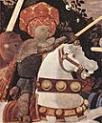
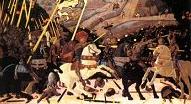
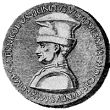
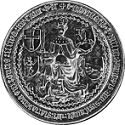


1432 On June 1 the Battle of San Romano sees 6K troops of Florence under condottiero Niccolo (Niccolò) Mauruzi (Maruzzi) da Tolentino (1350-1435) (not to be confused with St. Nicholas of Tolento, who died in 1305) fight the troops of Siena under Francesco Piccinino; after 6-7 hours both sides claim a V, taking 400-600 POWs each; Florentine painter Paolo Uccello (1397-1475) later (1438-40) paints the battle, and makes it look like guess who came out on top? On Nov. 18-19 the Battle of Delebio in the Valtellina is a V for the troops of Duke Filippo Maria Visconti Milan, led by condottiero Niccolo Piccinino (1386-1444) over the papal league forces of Venice. Sigismund I Kestutian (Kestutaitis) (1351-1440) (born pagan then baptized Roman Catholic in 1382) starts a revolt against Svitrigaila (ends 1435), supported by ethnic Lithuanians and Poles, squeezing Big Svit out of Vilnius into Vitebsk. Jacqueline attempts in vain to incite a rebellion in Holland against Philip III the Good, then abdicates her countships for good in favor of Philip next year and croaks in 1436. The Ottomans under Murad II siege Constantinople, and withdraw after a stubborn defense by emperor John VII - brawny is three walls tough? John II (1418-58) becomes king of Cyprus (until 1458). The did-I-say uninhabited Azores are rediscovered (first time 1427) by Portuguese mariner Gonzalo (Gonçalo) Velho Cabral. A Christian rebellion in S Albania begins in the Ottoman-occupied Janina area, led (with secret Venetian help) by Skanderbeg (Scanderbeg) (George Castriotes) (AKA Lord Alexander) (1453-68), who was raised in a Muslim court under the name Iskender Beg, Bey of Dibra (ends 1443). The Schleswig War (begun 1425) is ended with a peace, whereby Eric VII of Denmark recognizes the conquests of the German nobles. Engelbrecht Engelbrechtson begins leading the Swedish lower classes in a revolt against Eric VII. Ponhea (Gam) Yat becomes king of Khmer, with capital city at Angkor Wat. The towns of Berlin and Cölln (Colln) merge. The U. of Caen in Lower Normandy is founded by Henry VI of England. The U. of Leuven (Louvaine) is founded. Births: Portuguese king #12 (1438-81) Afonso (Afonso) V (the African) (d. 1481) on Jan. 15 in Sintra Palace; son of Duarte I (1391-1438); father of Joao II (1455-95). Ottoman Constantinople-conquering sultan #7 (1444-6, 1451-81) Mehmed (Mehmet) II (the Conqueror) (d. 1481) on Mar. 30 in Edirne; son of Murad II (1404-51) and Huma Haturi; father of Bayezid II (1447-1512). Italian "Morgante" poet Luigi Pulci (d. 1484) on Aug. 15 in Florence. English chancellor (1460-7, 1470-1) and archbishop of York (1465-76) George Neville (d. 1476); youngest son of Richard Neville, 5th earl of Salisbury and 14th earl of Warwick (1400-60); brother of Richard Neville, 6th earl of Salisbury and 15th earl of Warwick (1428-71); educated at Balliol College, Oxford U. Italian explorer Alvise Cadamosto (Alvida da Ca'da Mosto) (d. 1483) in Ca'da Mosto, Venice. Japanese samurai warrior-poet (founder of Edo Castle) Ota Dokan Sukenaga (d. 1486). French composer Antoine Busnoys (d. 1492). Japanese hero Hojo Soun (Ise Shinkuro) (d. 1519). Deaths: Jerusalem king (1398-1432) Janus of Cyprus (b. 1375) on June 29 in Nicosia.


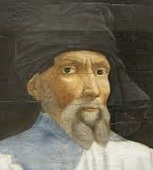
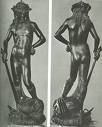
1433 On May 10 Florence is conquered after a 4-year war (begun 1429) with Lucca, and on Sept. 7 he is summoned to the signory (govt.) palace in Florence, where his enemies the Albizzi try to frame him as a scapegoat, and get him imprisoned and sentenced to a 10-year exile; lucky he wasn't just pushed out the window?; Filippo Brunelleschi suspends work on the Duomo. On May 31 after being crowned king of Italy in Milan on Nov. 25, 1431, Sigismund I of Luxemburg (1368-1437) is finally crowned HRE in Rome by the pope (until Dec. 9, 1437), becoming the first HRE to officially adopt the old Roman double-headed eagle as the armorial of the Holy Roman Empire spread the news to the world like a pigeon from hell? On Aug. 14 king (since Apr. 6, 1385) John I (b. 1357) dies of the plague, and his son by Queen Philippa of Portugal Duarte (Edward) I "the Philosopher" "the Eloquent" (1391-1438) becomes king #11 of yellow jacket trap Portugal (until Sept. 9, 1438), going on to summon the Cortes (nat. assembly) 5x to help guide him while financing his brother Henry the Navigator in the maritime exploration of Africa. The Chinese Exploratory Voyages begun in 1405 end with the return of eunuch Chinese adm. Cheng Ho (Zheng He) (1371-1433) f rom his 7th voyage after having gone as far W as America?; China isolates itself from the "backward" outside world, burns all the ships, shipyards, and records, and makes it a crime to go to sea from China in a multi-masted ship - boy do they have a surprise coming from those *!?*! backward barbarians? Philip III the Good finishes conquering Holland and Zeeland, and Zeeeland is ceded to Burgundy by Countess Jacqueline. The Berbers conquer Timbuktu. Le Thai-To dies after setting up a nat. univ. and a Chinese-style exam system and attempting to redistribute land according to the Chinese equal-field system; several short reigns in Vietnam follow, dominated by regents; a tributary mission is sent every three years to the Ming court. Humphrey of Gloucester, brother of Henry V acquires land in Greenwich, and has the Greenwich Royal Park enclosed. King Ponhea Yat abandons Angkor Wat and moves his court to Basan. Inventions: Tibetan saint Thangtong Gyalpo (Chakzampa) (1385-1464) invents the Iron chain suspension bridge, building eight in E Bhutan; the last one is washed away in 2004. Science: German superbrain Nicholas of Cusa (1406-64) proposes the Borda Count as a method for electing Holy Roman emperors, where each candidate is given a point value corresponding to rank by each voter, and the best total wins. Nonfiction: Nicholas of Cusa (1406-64), De Concordantia Catholica; written while attending the Council of Basel. Guo Chongli and Ma Huan, The Overall Survey (Captivating Views) of the Ocean's Shores; the Seven Voyages of Cheng Ho (1371-1433). Pedro, Duke of Coimbra (1492-49), Tratado da Virtuosa Benfeitoria (6 vols.). Art: Jan van Eyck (1390-1441), Man in a Red Turban. Donatello (1386-1466), Nude Statue of David (bronze statue) (begun 1425); first freestanding nude male sculpture made since antiquity, and first unsupported standing bronze work cast during the Renaissance; a nude dangly statue with David sporting a strange gay hairstyle and bonnet; stands in the center of the Medici Palace courtyard until 1440; not really finished until the 1440s? Masolino (1383-1447), Cycle of 300 Famous Historical Figures in the Orsini Palace in Rome (1433-4). Births: French duke of Brittany (1458-88) Francis II (d. 1488) on June 23; son of Count Richard of Etampe; grandson of Duke John V. Italian Neoplatonist philosopher-scholar (trans. of Greek classics esp. Plato into Latin, and founder of the Florentine Academy) Marsilio Ficino (d. 1499) on Oct. 19 in Figline Valdarno, Repub. of Florence. French Valois duke of Burgundy (1467-77) (last) Charles the Bold (Terrible) (d. 1477) on Nov. 21 in Dijon; son of Philip III the Good (1396-1467) and Isabel of Portugal (1397-1471). Hungarian soldier-statesman Laszlo Hunyadi (d. 1457); eldest son of John Hunyadi (1387-1456) and Erzsebet Szilagyi (1410-83); brother of Matthias Corvinus (1443-90). German painter Hans Memling (Memlinc) (d. 1494); grows up in Mainz; studies in Brussels under Rogier van der Weyden (1399-1464), then moves to Bruges. Moldavian Christian prince (1457-1504) Stephen III "the Great" (d. 1504) in Borzesti, Romania; of the house of Musat; son of Bogdan II (1409-51). Italian "Hypnerotomachia Poliphili" Dominican priest-monk Francesco Colonna (d. 1527) (b. 1434?). Deaths: Portuguese king (1383-1433) Joao (John) I the Great (b. 1357) on +Aug. 14 (plague). Chinese adm. Cheng Ho (Zheng He) (b. 1371) in Calicut, India. Japanese Ashikaga pretender emperor #6 (1382-1412) and emperor #100 (1392-1412) Go-Komatsu (b. 1377) on Dec. 1.




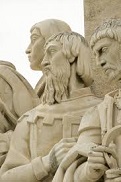



1434 On May 30 Prokop the Great (b. 1380) leads his Taborites at the Battle of Lipany (Lipan) (Cesky Brod) 25 mi. E of Prague, but is defeated and KIA by an army of Ultraquist nobility and Bohemian Roman Catholics called the Bohemian League. On June 1 grand duke (since May 1377) Wladyslaw II Jagiello (AKA Jogaila) (b. 1362) dies, and his 10-y.o. eldest son Wladislaw (Vladislaus) (Vladislav) III (1424-44) becomes king of Poland (until 1444), with Cardinal Zbigniew Olesnicki (1389-1455) as regent (until 1438); too bad, a group of Polish magnates prefer Hohenzollern elector Friedrich (Frederick) II (Iron) (Irontooth) of Brandenburg (1413-71), who was betrothed to Wladyslaw II's daughter Jadwiga of Lithuania (1408-31) until she suddenly died in 1431 (poisoned?) and left him without a pot to piss in legally, but that doesn't stop noble Hussite leader Spytek (Spytko) of Melsztyn (1398-1439) from interrupting the coronation. On June 20 Zara (Zar'a) (Zera) Yaqob (Ya'qob) (Yacob) (Seed of Jacob) (1399-1468) becomes Solomonic emperor of Ethiopia (until 1468), becoming their greatest ruler until Menelik II (1889). Pulling every string he has (incl. the pope), Florentine banker Cosimo di Giovanni de' Medici the Elder (1389-1464) returns to Florence from exile, ousts the Albizzis, and modestly accepts rule of the city (without holding office himself) until his death on Aug 1, 1464, becoming posth. known as "the Father of the Nation", founding the Medici Dynasty; "Political questions are decided at his house... He is king in everything but name" (an admirer); the pope opens a huge credit line with the Medicis, who become the richest house in Europe, resuming their patronage of the arts; hands-on kind of guy Filippo Brunelleschi (1377-1446) resumes work on the dazzling 4M-brick Duomo (begun 1420) with the cool cupola, and completes it without using scaffolding after inventing a reversing screw allowing oxen power to be used; a revolt in Rome causes Pope Eugene IV to flee to Florence, using German superbrain Nicholas of Cusa (1406-64) as his rep. in Germany, causing him to become known as "the Hercules of the Eugenian cause". Engelbrecht Engelbrechtson ravages E and S Sweden, capturing castles and kicking out the bailiffs. Milanese forces under Niccolo Picinino defeat papal forces at Castel Bolognese. Count Amadeus VII of Savoy hands over much of his authority to his son Louis (Ludovico) (Lodovico) I of Savoy (1413-65), and retires to a hermitage, while his son marries Anne de Lusignan (1418-62), heir of Cyprus and Jerusalem, and goes on to bear 19 children, 14 of whom survive their youth, and in 1453 receives the cool Shroud of Turin from Margaret de Charny; he also becomes a probable patron of Leonardo da Vinci. Lithuanian grand prince Sigismund Kestutaitis gives nobles of Eastern Orthodox faith equal rights to Roman Catholic ones, and guarantees that no noble can be imprisoned without a court proceeding. The Khmer royal court moves from Basan to Phnom Penh. The Aztec Triple Alliance of Tenochtitlan (Aztecs), Texcoco, and Tlacopan (Tacuba) is formed, creating the most prosperous urban society in Mesoamerican history; genius-poet-engineer King Nezahualcoyotl (Coyote Who Fasts) (1402-72) of Texcoco (designer of a 9-mi. dam across Lake Texcoco) thrives in his 300-room palace with 40 wives, 60 sons, and 57 daughters, collecting the first zoo in the New World. After sailing from Lagos, Portuguese explorer Gil Eannes (Eanes) (1395-) rounds Cape Bojador (Bulging Cape) S of the Canary Islands on the W coast of Africa (modern-day Mauritania) in a modified fishing barquentine, and discovers the Rio de Ouro (Oro) to the S, bringing back wild roses to Sagres to prove their success, after 10 years of trying and 14th attempts, delighting Prince Henry the Navigator and opening the Portuguese Age of Discovery in Africa; next year he and and Afonso Goncalves Baldaia (1415-81) sail two ships 150 mi. S of the cape, reaching the African coast; the year after that Baldaia sails farther S along the coast of Western Sahara and collects thousands of monk seal skins before becoming the first Euro to cross the Tropic of Cancer and reach Pedra da Gale (Galha Point), becoming the first commercial cargo brought to Europe from West Africa; too bad, failure to find any natives to kidnap causes Prince Henry to not authorize another expedition until 1441 - more big strong Mandingos to kidnap? The town of Wurzburg (Würzburg), Germany bans beer brewing "forever"; too bad, in 1437 the climate of C Europe reverses its warming trend and experiences harsh winters that decimate the vineyards of S Germany, causing wine to have to be imported from Italy, inflating prices, causing beer bootleggers to spring up; it takes until 1642 for brewing to be relegalized. The U. of Catania in Catania, Sicily is founded, becoming the first univ. in Sicily. Inventions: After inventing artistic perspective based on a central vanishing point in 1405-25, Florentine architect Filippo Brunelleschi (1377-1446) pub. Rules of Perspective, getting all the credit for it, although Masolino ("Little Tom") da Panicale (Tommaso di Cristoforo Fini) (1383-1447) was the first to make use of it in a painting in 1423; it takes until Raphael (1483-1520) for all the intricacies to be understood. King Sejong of Korea makes a clepsydra (Gr. "water thief") (water clock), the first publicly-displayed clock; also a bronze sundial. Nonfiction: Gong Zhen, Records of Foreign Countries in the Western Ocean; the Seven Voyages of Cheng Ho (1371-1433). Art: Jan Van Eyck (1390-1441), Arnolfini Wedding Portrait. Births: Scottish queen consort Mary of Guelders (Gueldres) (d. 1463); daughter of duke Arnold of Guelders and Catherine (daughter of Duke Adolph IV of Cleves); niece of Duke Philip III the Good of Burgundy; wife (1449-60) of James II (1430-60); mother of James III (1452-88). French cardinal-archbishop (of Lyons) Charles II of Bourbon (d. 1488) in Chateau de Moulins; son of Charles I of Bourbon (1401-56) and Agnes of Burgundy (1407-76) (daughter of John the Fearless); brother of John II of Bourbon (1426-88) and Peter II of Bourbon (1438-1503). Italian Renaissance poet-humanist Matteo Maria Boiardo, Conte di Scandiano (d. 1494) near Scandiano, Reggio Emilia. German painter-printmaker Michael Wolgemut (d. 1519). Deaths: Lithuanian (1377-1434) and Polish (1386-1434) king Wladyslaw II Jagiello (b. 1351) on May 31/June 1 in Grodek Jagiellonski (Horodok, Ukraine) (near Lwow, Galicia). Italian writer Christine de Pizan (b. 1364) in Venice; leaves 300+ ballads.
1435 - The First Saeculum Year?
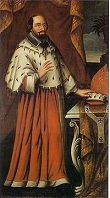

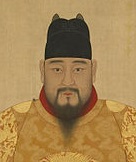
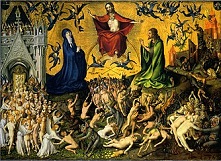
1435 The Cologne Witch Persecution in Germany begins, with 37 executed by 1655, most during the reign (1612-50) of archbishop Ferdinand of Bavaria (1577-1650). According to U.S. historians Robert Strauss and Neil Howe in their 1997 book The Fourth Turning, this is the first of four 80-to-100-year Saeculums, each with four generations, containing a turning point every 20 years or so. On Jan. 31 emperor (since June 27, 1425) Xuande (b. 1399) dies, and his son Yingzong (Zhengtong) ("right governance") (Tianshun) ("obedience to Heaven") (1427-64) becomes Ming emperor #6 of China (until 1449), going on to have an interior Great Wall of China built to make it stronger. On May 11 the Abbot of the Herzogenburg monastery in the Waldvertiel (wooded quarter) in W Lower Austria draws up a deed granting Hannsen Hydler and his wife some property near Raabs on the Thaya River for 40 pounds; by 1702 the name is spelled Hitler (from Heidjer, meaning heathen) - Heil Heathen? In May the Swedish Riksdag (Diet) of 1435, with reps from all four orders meets in Arboga, and caves-in to Engelbrecht Engelbrechtson, electing him regent; the Riksdag continues as an institution for the next four cents. In May the Battle of Gerberoy is a V for the French led by the late Joan of Arc's loyal companion La Hire (Etienne de Vignolles) (1390-1443)) over the English led by John FitzAlan, 14th earl of Arundel, with 1K English casualties vs. zero French casualties, causing L Hire to be made capt.-gen. of Normandy in 1438. On Sept. 1 the Battle of Pabaiskas (Vilkomir) near Ukmerge in Lithuania sees Sigismund Kestutaitis, with the help of the Poles defeat Svitrigaila and his Livonian Order allies, ending their power in Lithuania; Sigismund Korybut dies of his wounds, his followers claiming the Polish poisoned them; Little Svit flees to exile in Wallachia, where he becomes a lowly shepherd; in 1438 Kestutaitis begins negotiations with HRE Albert II in an attempt to loosen ties with Poland, but dies in 1440 before it gets very far. Burgundian duke Philip III the Good tries to conquer Calais (ends 1439) after deserting Henry VI and Joan-burner John of Lancaster, acknowledges dauphin Charles as Charles VII of France, and finally accepts Charles' disavowal of the murder of his father and pledge to punish the true murderers, signing the Peace (Treaty) of Arras; meanwhile on Sept. 14 John of Lancaster (b. 1389) dies in Rouen while negotiating a treaty, and since nobody can take his place, the English cause in France is lost; Dieppe is recaptured from the English, who held it since 1420 - you burned a virgin over your problem with Anglo-Saxon sex what? Joanna II of Naples dies, and Alfonso V (the Magnanimous) (1396-1458) claims the throne, vying with rival Rene of Anjou and occupying Naples. Duke Albert V of Austria awards his sons, AEIOU man Austrian Archduke Frederick V (later HRE Frederick III) (1415-93) and Albert VI (the Prodigal) (1418-63) rule over of Inner Austria (Styria, Carinthia, and Carniola), beginning a long rivalry. Abu Amr Uthman (-1488) becomes Hafsid ruler of Morocco in Ifriqiya in N Africa (until 1488), making vassals of the Zayyanids in W Algeria and the Wattasids in Morocco. The Italian houses in Venice consolidate to form the Guild of Mercury. Inventions: Movable type is used by Dutch printers in Haarlem. Nonfiction: Leon Battista Alberti (1404-72), Della Pictura (On Painting); first book to treat painting as a liberal art as opposed to a mere craft, and the first book illustrating the laws of perspective. Art: Jan Van Eyck (1390-1441), The Virgin of Chancellor Rolin. Stefan Lochner (1409-52), The Last Judgment. Rogier van der Weyden (1399-1464), The Descent from the Cross; St. Luke Drawing a Portrait of the Madonna. Births: Italian sculptor Andrea della Robbia (d. 1525) on Oct. 24 in Florence; son of Marco della Robbia, brother of Luca della Robbia (1399-1482); inherits his uncle Lucca's terra cotta workshop in Florence. Italian Renaissance sculptor Bertoldo di Giovanni (d. 1491) in Florence; pupil of Donatello. Bavarian painter-woodcarver Michael Pacher (d. 1498). Dutch (Flemish) composer Johannes Tinctoris (d. 1511). Deaths: Polish-Lithuanian king Wladyslaw II Jagiello (b. 1362). English Joan-burning duke (of Bedford) John of Lancaster (b. 1389) on Sept. 14 in Rouen. Lithuanian duke Sigismund Korybut (b. 1395) in Sept.; KIA in the Battle of Pabaiskas. Italian breed mare Joanna II of Naples. Azerbaijani scholar-musician-composer Abd al-Qadir al-Maraghi (b. ?); leaves musical compositions that are #1 hits on the Ottoman pop chart - Ottoman Idol? Turkish White Sheep ruler (since 1403) Qara Uthman.



1436 On July 5 the Compacts (Compactata) of Basle (Iglau) are ratified in Jihlava by the estates of Bohemia and Moravia, and ratified by the Council of Basel next Jan. 15, ending the Hussite Wars (begun 1419) between Roman Catholic and Hussite Bohemia, confirming the Hussite denomination, recognizing them as true sons of the Church with the right to the cup in Communion, and creating religious dualism for the first time in Roman Catholic Europe; Sigismund I is acknowledged as king of Bohemia, but dies next Dec. 9 while trying to stir up the Catholics again, allowing the communion under both kinds (the wafer and the cup) is acknowledged as not heretical on Dec. 23 - before they have to prove he isn't? On Sept. 10 an English force under Henry Percy, 2nd earl of Northumberland and George de Dunbar, 11th earl of March is defeated by the Scots under William Douglas, 2nd earl of Angus, warden of the Scottish Marches at the Battle of Piperdean near Cockburnspath, Berwickshire, failing to take back the Castle of Dunbar; meanwhile James I of Scotland launches a campaign to recapture English-held Roxburgh Castle on the English-Scottish border, causing Henry Percy to march to the relief of Roxborough, sieging it and dispersing the Scots under James I after 15 days in the Dirtin Raid after his army proves not too eager to follow a Scottish Longshanks, causing him to flee from the field with them bringing up the rear, causing his expensive Dutch artillery incl. the Lion to be captured; when James I goes to parliament to get more money to renew the campaign, his uncle Earl Walter of Atholl puts up James I's bitter enemy Sir Robert Graham of Kinpunt (Killpont) (1375-1437) (who had been arrested in 1424 as a supporter of Earl Walter of Lennox) to attempting to get the king arrested in Parliament, and when it fizzles the king gets Graham arrested and banished; meanwhile in 1434 James I, always trying to secure Scottish prestige in Europe arranges the marriage of his gorgeous 12-y.-o. daughter Margaret Stewart (1424-46) to the French dauphin Louis, who is transported to France in 46 ships by Adm. William Sinclair, 1st Earl of Caithness, last Earl of Orkney (1410-80), builder of Rosslyn Chapel in Roslin, Midlothian; too bad, the marriage is unhappy, and she dies before becoming queen, wearing a tight corset to keep from becoming pregnant, but he gets other daughters betrothed to the dukes of Brittany (married 1442) and Austria (married 1449) before his death. HRE Sigismund I confirms the protections of the Jews in Hagenau, but stops the grumbling by prohibiting the sale or lease of houses to new arrivals, while allowing the city to lease them "temporary" housing for exorbitant sums. Italian mendicant friar (St.) Francis of Paola (1416-1507) founds the mendicant Minim Friars, "least of all the faithful". Ashton-under-Lyne on the Tame River (tributary of the Mersey River) 6 mi. E of Manchester becomes a market center. Nonfiction: Fei Xin, The Overall Survey of the Star Raft; the Seven Voyages of Cheng Ho. Poetry: Anon., Libel of English Policie; starts by "exhortynge alle Englande to kepe the see enviroun", and warns of the danger that English abuses in Ireland might let it pass into other hands. Births: German Renaissance mathematician-astronomer and Roman Catholic bishop Regiomontanus (Joannes de Regio Monte) (Johannes Müller von Königsberg) (d. 1476) on June 6 in Unfinden (near Konigsberg), Franconia (modern-day Bavaria); educated at the U. of Leipzig, and U. of Vienna; pupil of Georg von Purbach (1423-61). Italian artist-alchemist Andrea del Verrocchio (Andrea di Michele di Francesco de' Cioni) (d. 1488) in Florence; teacher of Leonardo da Vinci, Perugino, Ghirlandaio, and Sandro Botticelli. Polish-Lithuanian queen consort and breed mare (1454-92) ("Mother of the Jagiellons") Elizabeth of Austria (Hapsburg) (d. 1505) in Vienna; daughter of HRE Albert II (1397-1439) and Elisabeth of Luxembourg (1409-42); grandcaughter of HRE Sigismund I; brother of Ladislaus Posthumous; wife (1454-) of Casimir IV of Poland (1427-92); grows up in the court of HRE Frederick III; mother of Vladislaus II (1456-1516), John I Albert (1459-1501), Alexander (1461-1506), Sigismund I (1467-1548), Frederick (1468-1503), Jadwiga of Bavaria (1457-1502), Sophia of Brandenburg-Ansbach (1464-1512), Anna of Pomerania (1476-1503), Barbara of Saxony (1478-1534), and Elizabeth of Silesia (1481-1517). Spanish Franciscan Complutensian Polyglot Bible statesman-cardinal Francisco (Gonzalo) Jimenez (Ximenes) de Cisneros (d. 1517) in Torrelaguna, Castile; founder of the Complutense U. (U. of Madird). Deaths: Bavarian frustrated countess Jacqueline of Hainaut (b. 1401).
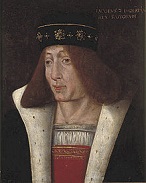





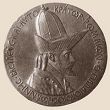

1437 On Jan. 3 Catherine of Valois (b. 1401) dies during childbirth in London, and her son Henry VI (b. 1421) of England is declared of age, but he proves to be a gentle, generous, well-meaning but weak king whom his nobles push around, and is unfit to rule, and the regency council stays in power amid factions and favorites and disorder, while nobles maintain private armed retainers (livery and maintenance) and fight private wars, growing rich with the innovation of sheep farming with enclosures?; the Beauforts make Henry V their puppet, getting Duke Edmund Beaufort of Somerset and his friend the earl of Suffolk promotions in the govt. On Feb. 20 (Lent) after his nearest male relative Robert Stewart, grandson of Earl Walter Stewart of Atholl lets them into his lodgings in the Dominican convent at Perth, Scottish king (since Apr. 4, 1406) James I (b. 1394) is assassinated by Robert Graham and armed servants of Duke Robert Stewart of Albany, incl. Thomas Chambers, Christopher Chambers, and the two Barclay brothers after he tries to squeeze through a sewer tunnel which he had just had blocked to prevent balls from being lost from his tennis court, causing him to become trapped like a rat until he is stabbed to death; Queen (since Feb. 2, 1424) Joan Beaufort (1404-45) is wounded but escapes, sending word to Edinburgh to remove John Spens, a known Atholl man from guardianship of her 6-y.-o. son Duke James of Rothesay and replace him with trusted John Balfour; she then goes on a revenge tour, getting the papal nuncio Bishop Anthony Altani of Urbino to declare her butchered hubby a martyr at his funeral, then have the conspirators tracked down and given the English-style hanging, drawing, and quartering; she becomes regent of Scotland until 1439 for her and James I's birthmarked son James II (Fiery Face) (1430-60), who on Feb. 21 becomes king of Scotland (until Aug. 3, 1460), and is crowned at Holyrood Abbey (where he was born) on Mar. 25, becoming the first Scottish king not crowned at Scone (too close to Perth); the marriage of James I's sister Margaret Stewart to Archibald, 4th earl of Douglas gives the Douglases a claim to the regency, and they begin ruling Scotland out of Edinburgh, with James II's 1st cousin Archibald Douglas, 5th Earl of Douglas (1390-1439) becoming regent of Scotland and its most powerful man (until 1439); meanwhile the Stewart-Douglas rivalry rages on. On Sept. 13-Oct. 19 after Duarte I's brothers Prince Henry the Navigator and Ferdinand the Holy Prince talk him into, against the advice of the pope, Duke Peter of Coimbra, and Infante John, the Battle of Tangier (Siege of Tangiers) is a decisive D for 6K-8K Portuguese after a relief army of 100K Moroccans led by vizier Abu Zakariya Yahya al-Wattasi (-1448) arrives, encircles them, and starves them into submission until Prince Henry signs a treaty giving back the citadel of Ceuta (captured in 1415) and surrendering his brother Prince Ferdinand as a hostage; too bad, he later reneges, and Ferdinand dies in captivity in 1443; the Portuguese unsuccessfully siege the city 3x more in this cent. On Oct. 18 Richard Plantagenet, 3rd duke of York marries Cicely Neville (1415-95), "the Rose of Raby" (daughter of Ralph Neville, 4th Baron Neville), who has four sons, incl. kings Edward IV and Richard III; after a few successes he is replaced by the Earl of Warwick as regent in France (until 1439). In Dec. HRE Sigismund (b. 1368) dies, becoming the last HRE of the Luxembourg Dynasty; before his death he transfers Brandenburg to Frederick I of Hohenzollern (1371-1440), founder of the Hohenzollern Dynasty; he wills his titles of king of Germany, Hungary, and Bohemia to his Hapsburg son-in-law (hubby of his daughter Elizabeth, by 2nd wife Barbara of Cilli) Duke Albert (Albrecht) V of Austria (a descendant of Bela IV of Hungary), who becomes uncrowned HRE Albert II of Hapsburg (1397-1439) (until Oct. 27, 1439) - I can turn into a bat, a butterfly, or a toad, and if you don't come to see me I will haunt you? Byzantine emperor (since 1425) John VIII Palaeologus (Palaiologos) (1392-1448) appoints Latin-speaking theologian Isidore of Kiev (Thessalonica) (1385-1463) as metropolitan of Kiev, Moscow, and all Russia in an attempt to unite the Russian Orthodox Church with the Roman Catholic Church and gain Constantinople's protection against the horrible Ottomans; Russian grand prince Vasily II doesn't accept him, but Isidore of Kiev still manages to talk him into allying with Roman Catholicism to save the Byzantine Empire and the Orthodox Church of Constantinople, and receives funding from him. On Sept. 13-Oct. 19 after Duarte I's brothers Prince Henry the Navigator and Ferdinand the Holy Prince talk him into, against the advice of the pope, Duke Peter of Coimbra, and Infante John, the Battle of Tangier (Siege of Tangiers) is a decisive D for 6K-8K Portuguese after a relief army of 100K Moroccans led by vizier Abu Zakariya Yahya al-Wattasi (-1448) arrives, encircles them, and starves them into submission until Prince Henry signs a treaty giving back the citadel of Ceuta (captured in 1415) and surrendering his brother Prince Ferdinand as a hostage; too bad, he later reneges, and Ferdinand dies in captivity in 1443; the Portuguese unsuccessfully siege the city 3x more in this cent. Transylvanian gov., frontier lord and Hungarian patriot John (Janos) Hunyadi (1387-1456) leads a counteroffensive against the Ottomans (until 1444), and scores his first V over the Turks. Christ's College at Cambridge U. is founded by clergyman William Byngham (Bingham) (1390-1451) as God's House to train grammar school teachers, becoming the first known secondary school training college; in 1505 it is refounded as Christ's College. Inventions: John Dunstable develops counterpoint in musical composition - but that doesn't mean that whites will ever get rhythm? Births: Wallachian prince (1462-75) Radu (the Handsome) (d. 1475); son of Vlad II Dracul (1390-1447); brother of Miracea II (1427-47) and Vlad III Dracula (1431-76). English queen consort (1464-83) Elizabeth Woodville (Wydeville) (Widvile) (d. 1492) on Feb. 3 in Grafton Regis, Northamptonshire; daughter of Richard Woodville, 1st earl Rivers (1405-69) and Jacquetta of Luxembourg (1415-72); granddaughter of Margaret de Baux (1394-1469); maternal descendant of John I of England; wife of Edward IV; mother of the "princes in the Tower" Edward V (1470-83) and Richard of Shrewsbury, duke of York (1473-83). Spanish Jewish statesman-theologian Isaac Ben Judah Abravanel (Abrabanel) (Abarbanel) (d. 1508) in Lisbon; treasurer of Alfonso V of Portugal; expelled from Spain in 1492; father of Judah Abrabanel (Leo Hebraeus) (1460-1535). German meistersinger Hans Folz (d. 1513) in Worms. Deaths: Italian humanist Niccolo Niccoli (b. 1364). German king (1411-37) and HRE (1433-7) Sigismund (b. 1368) on Dec. 9 in Znaim (Znojmo), Bohemia; last Luxembourg HRE. Scottish king (1406-37) James I (b. 1384) on Feb. 20 in Perth (assassinated); buried in the Carthusian Priory near Perth; leaves the poem The Kingis Quair (The King's Book) (the king is what?), about his love for the Dominican nuns of Perth, er, his babe Queen Joan. English queen Catherine of Valois (b. 1401) on Jan. 3 in London (dies during childbirth); buried in Westminster Abbey; her grandson Henry VII destroys her alabaster memorial to coverup his flaky ancestry, and her coffin lid is raised, after which her corpse becomes a tourist attraction, being kissed on Shrove Tuesday, 1669 by Samuel Pepys. Scottish leader William, 2nd earl of Angus (b. ?) in Oct.


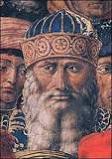



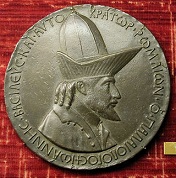


1438 On Jan. 1 Archduke Albert V of Hapsburg (Austria) is crowned king of Hungary and Croatia; on Mar. 18 after Frederick of Brandenburg, candidate of the German reformers withdraws, Albert V, husband of HRE Sigismund I's daughter is magnanimously, er, unanimously elected king Albert II (the Magnanimous) (1397-1439) of Germany (until Oct. 27, 1439) (and of the Romans, although never crowned HRE), founding the Hapsburg (Habsburg) Dynasty of the Holy Roman Empire; in return he has to sign capitulations to the nobles, who are no longer obliged to fight beyond the frontiers; all future HREs except Charles VII and Francis I are Hapsburgs, with those from 1765-1806 being of the House of Hapsburg-Lorraine; rival Wladislaw III of Poland begins a civil war (ends 1439); in June Albert II is crowned king of Bohemia, but is never able to obtain possession of it, fighting the Bohemians and their Polish allies for it. On Feb. 8 Byzantine emperor (125-48) John VIII Palaeologus arrives in Venice with a retinue of 700 incl. Constantinople patriarch Joseph II and 20 metropolitans, plus other big brains incl. Neoplatonist philosopher Gemistus Pletho (Plethon) (Georgius Gemistus) (1355-1452), who advocates a return to the Olympian gods, and his student Johannes (Basilius) (Basilios) Bessarion (1403-72); on Apr. 9 the Ecumenical Council of Ferrara convenes, with the patriarch refusing to kiss the pope's foot and instead bowing and kissing his cheek; John VIII Palaeologus pleads for assistance from the Turks encircling Constantinople, proposing a union of the Greek and Roman Catholic Churches; Pletho goes on to meet with Cosimo de' Medici, who founds the Platonic Academy of Florence under Marsilio Ficino (1433-99), who translates all of Plato's works and other Neoplatonist works by Plotinus et al. into Latin, helping revive Greek learning in W Europe; the academy is dissolved after the 1492 death of Lorenzo de' Medici (b. 1449). In Mar. a 9-year English-Scottish Truce is signed, effective from May 1 of this year until May 1, 1447, with a bipartisan commission of conservators to enforce it - time out from fighting for their free-ee-dom? On Sept. 9 king (since Aug. 14, 1433) Edward (Duarte) I the Philosopher/Eloquent (b. 1391) dies of the plague (grief over his impisoned son Ferdinand?) after appointing his unpopular foreign wife Eleanor of Aragon as regent, who wants his 6-y.-o. son Afonso V to be king instead of the older brothers, causing the burghers assembled by Infante John, Constable of Portugal to appoint Prince Pedro, Duke of Coimbra (b. 1392) as regent instead (until June 6, 1448), and on Sept. 13 his 6-y.-o. son Afonso (Alfonso) V (the African) (1432-81) becomes king #12 of Portugal (until Aug. 28, 1481). The Pragmatic Sanction of Mainz, a preliminary agreement between the papacy and the HRE settles the Holy Roman Empire in the House of Austria, abolishes annates, papal reservations, and provisions, and leaves the German church under imperial and princely control; rescinded in 1516. The Polish parliament in Piotrkow declares 14-y.-o. Wladyslaw III (b. 1421) old enough to assume personal rule, which doesn't satisfy the Polish nobles who didn't want him in the first place. Sultan Murad II leads the Ottomans against Transylvania and Hungary, ravishing them. The Jews are expelled from Augsburg. The Chinese occupation of Sri Lanka ends. Pachacutec ("he who remakes the world") (-1471) becomes king of Cuzco (until 1471), going on to conquer the South Am. continent and found the Inca (Tawantinsuyu) Empire, the largest in pre-Columbian Am. (ends 1533). Mongol Golden Horde Khan Ulugh Mohammed founds the town of Kazan near the Volga and Kazanka Rivers as his capital. All Souls College at Oxford U. is founded by Canterbury archbishop (since 1414) Henry Chichele (Chicheley) (Checheley) (1364-1443), with a warden and 40 fellowships (24 in arts, philosophy, and theology, 16 in civil or canon law) reserved for scholars who must take Holy Orders; Codrington Library is completed in 1751; undergrads are eliminated in the 19th cent. Architecture: The Doge's Palace in Venice (begun in 1309) is completed; the Doge's magnificent state barge is called the Bucentaur. The Jamma Musjid Mosque in Husain, Jaunpur is completed. Art: Pisanello (1395-1455), Portrait Medal of Byzantine Emperor John VIII Palaeologus; first-ever portrait medal, made after attending the Council of Ferrara; great for collectors. Paolo Uccello (1397-1475), The Battle of San Romano (1438-40). Poetry: Alfonso Martinez de Toledo (1398-1470), Libro del Arcipreste de Talavera (El Corbacho), o Reprobacion del Amor Mundano; inspired by Giovanni Boccaccio's "Corbaccio"; argues against sexual lust ("loco amor"), and lampoons women as inferior. Births: French duke of Bourbon (1488-1503) Peter II (d. 1503) on Dec. 1; son of Charles I of Bourbon (1401-56) and Agnes of Burgundy (1407-76) (daughter of John the Fearless); brother of John II (1426-88) and Charles II (1434-88). Deaths: Italian sculptor Jacopo della Quercia (b. 1371). Portuguese king (1433-8) Edward (Duarte) I (b. 1391) on Sept. 13 in Tomar (plague) (heartbreak over his imprisoned son Ferdinand?); leaves a revision of the Portuguese law code unifinished, along with The Loyal Counsellor and Book of Teachings on Riding Well on Every Saddle, becoming one of the oldest medieval manuals on horsemanship incl. jousting. Mamluk ruler (1422-39) Al-Ashraf Barsbay (b. ?).

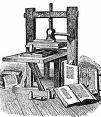

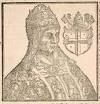
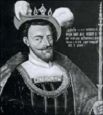


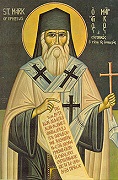
1439 The plague strikes Scotland again. On Jan. 10 after the plague strikes Ferrara, the Ecumenical Council of Florence (begun 1431) continues the Council of Ferrara under the patronage of Cosimo de Medici; on July 6 the Roman Catholic and Eastern Orthodox Churches sign a treaty uniting on paper, with 1-sided terms favoring Rome, in return for Pope Eugene IV calling for a new crusade against the pesky Turks; too bad, when the Byzantine prelates return home, the Orthodox pop. gets pissed-off and either replaces them or makes them repudiate the union; Hesychast metropolitan Manuel Eugenicus (Eugenikos) (St. Mark of Ephesus) (1392-1444) of Ephesus is the lone Orthodox prelate to refuse to sign the union proclamation, making him a hero and getting him canonized in 1456; too bad despite lobbying by metropolitan Isidore of Kiev, the Council of Basel (ends 1449) creates a fresh schism; on Dec. 18 after he gets talked into switching allegiances, Pope Eugene IV makes Johannes (Basilius) (Basilios) Bessarion (1403-72) a cardinal, causing him to remain in Italy, using his knowledge of Greek to collect Greek mss. while promoting humanist studies; too bad, Isidore's flock rejects any union with the Latins, and refuses to let him return, electing a new patriarch of their own; the whole affair ends Moscow's longtime loyalty to Constantinople, and when it falls in 1453 they take it as God's judgment on them, bolstered by the Legend of the White Cowl, which claims that Rome deviated from the true (Orthodox) faith because of "pride and ambition", a nd the New Rome (Constantinople) did ditto, leaving Russia as the Third and Final Rome. On May 4 the Battle of Grotniki near modern-day Nowy Korczyn sees the Hussites under Spytko of Mlesztyn (b. 1398) defeated and killed by Polish forces of Wladislaus III under Hincza of Rogow, ending Hussite influence in Poland. On June 24 Frederick IV of the Empty Pockets (b. 1382) dies, and his son Sigismund of Austria (1427-96) becomes Hapsburg archduke of Austria and Tirol (until 1490), getting into a war with Nicholas of Cusa, bishop of Brixen over the Inn, Isarco, and Pustertal Valleys. On Nov. 5 Duke Amadeus VIII of Savoy is elected antipope #7 of the Great Schism Felix V (1383-1451) in Avignon, becoming their last antipope (until Apr. 7, 1449). Philip III the Good gives up trying to conquer Calais - for good? On Oct. 27 uncrowned HRE Albert II (b. 1397) dies defending Hungary from a Turkish attack, and the magnates of Hungary offer the Hungarian crown to Wladyslaw III of Poland, which pisses-off some Polish magnates, along with Albert II's widow Elisabeth of Bohemia (daughter of HRE Sigismund I), who has the Hungarian crown stolen from its guardians in Visegrad by court lady Helene Kottanerin and secreted in Wiener Neustadt (causing the cross on top to become askew), then begins a civil war (ends 1440) to keep it for her bun-in-the-oven child Ladislaus Posthumous (b. 1440). Erik VII is deposed in Sweden and Denmark and flees, and the Danish council elects his nephew Christopher of Bavaria (son of his sister Catherine and her hubby John, son of HRE Rupert) as Christopher III (1416-48), becoming a puppet of the Hansa towns and renewing their privileges despite protests by Danish burghers; he starts out by buying the loyalty of Count Adolf VIII of Holstein by granting him the entire duchy of Schleswig as a hereditary fief under the Danish crown. Archibald, 5th earl of Douglas dies of the plague, leaving 13-y.-o. William Douglas, 6th Earl of Douglas (1426-40) as his heir, who is too young to be lt.-gen. of Scotland; meanwhile former "King's Quhair" Queen (1424-37) Joan Beaufort (-1445), regent for young James II is arrested after marrying James Stewart, the Black Knight of Lorne (1399-1451) without permission, then released after signing the Appoyntement, giving up all political power, allowing the unlikely combo of new chancellor Lord William Crichton, 1st Lord Crichton (-1454) (son of John de Crichton, who died in 1406), keeper of Edinburgh, and Sir Alexander Livingston of Callendar (-1451) (owner of Stirling Castle) to come to power. The Ottomans conquer Serbia and make the ruler of Bosnia a tributary; the majority of the Christians who embrace Islam come from the Bogomils sect. The heirs to the French throne begin to receive the title of Conte du Dauphine. The Taille, an exceptional direct land tax on French peasants and non-nobles becomes permanent after Charles VII is granted the right to collect taxes to support a standing army, becoming hated by the people. Inventions: Speaking of wizards, about this year German goldsmith Johannes Gutenberg (1398-1468) of Mainz invents a process for mass-producing movable type using a hand mold for a screw-type wooden Printing Press using oil-based ink; the Info. Explosion begins. Poetry: Juan Rodriguez de la Camara (1390-1450), Siervo Libre de Amor; chivalresque romance. Births: Portuguese queen consort of Castile and Leon (1455-74) Joana (Juana) of Portugal (d. 1475) on Mar. 20 in Quinta do Monte Olivete, Almada; daughter of Edward of Portugal (1391-1438) and Eleanor of Aragon (1402-45); wife (1455-) of Henry IV of Castile (annulled); mother of Juana la Beltraneja (1443-92). Italian painter Cosimo di Lorenzo Filippi Rosselli (d. 1507) in Florence; teacher of Piero di Cosmo (1462-1521). German Gothic sculptor Veit Stoss (d. 1533) in Nuremberg; student of Michel Wohlgemuth. Deaths: Austrian duke (1402-39) Frederick IV (b. 1382) on June 24. Scottish leader Archibald, 5th Earl of Douglas (b. 1390) on June 26 (plague); enbombed in St. Bride's Kirk in Douglas, Lanarkshire. German king (1438-9) Albert II of Hapsburg (b. 1397) on Oct. 27 in Neszmely (KIA fighting Turks).